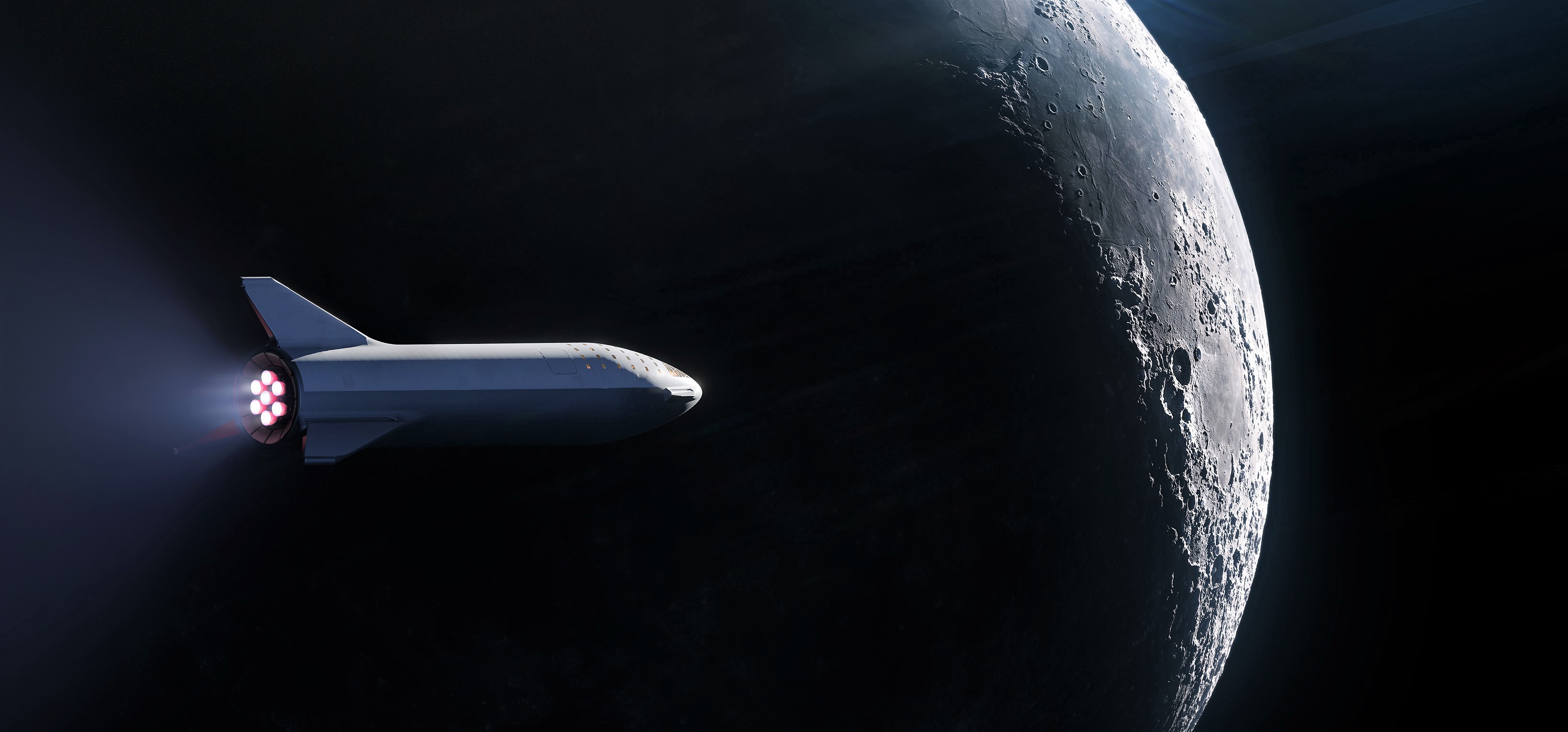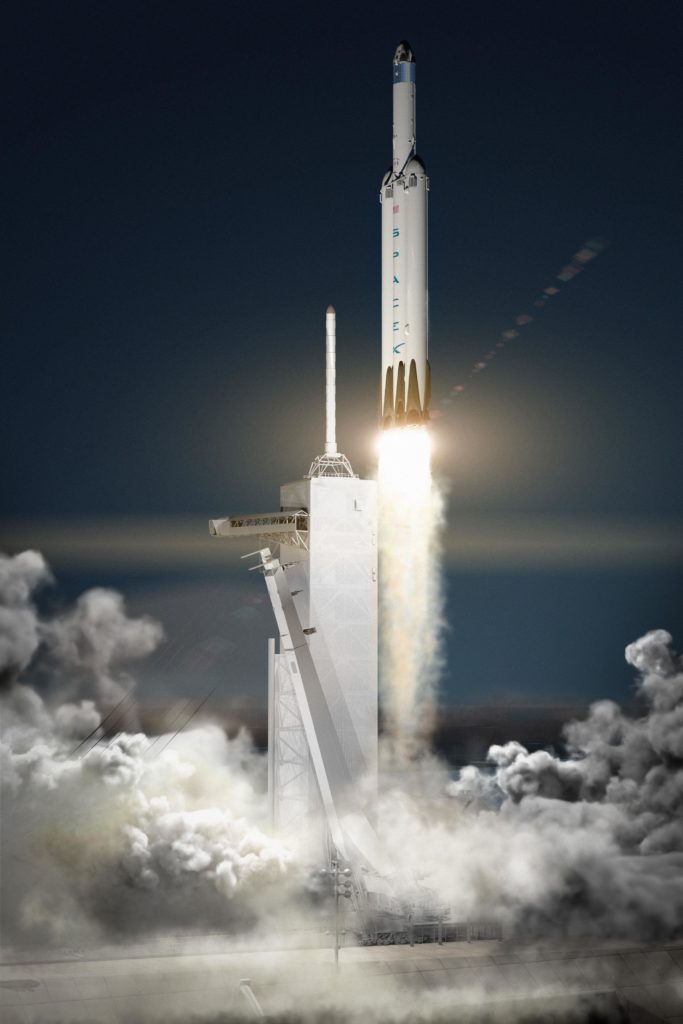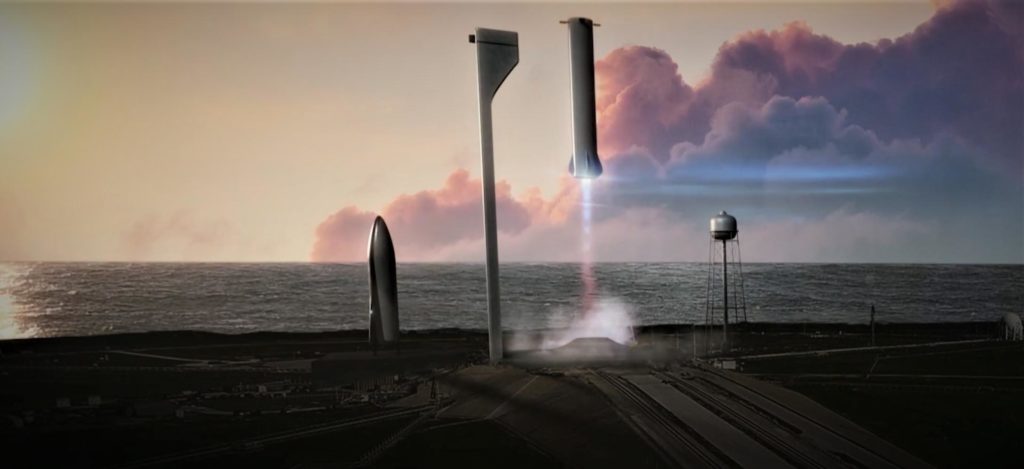

News
SpaceX to give BFR update and announce a private Moon mission on Monday
SpaceX is set for a surprise event that is expected to revolve the announcement of a newly-contracted launch planned to send a private individual around the Moon with BFR, potentially queuing up a true race (back) to the Moon between SpaceX and NASA sometime in the early to mid-2020s.
Alongside the official announcement and a fascinating render revealing a dramatically-updated iteration of BFR’s spaceship upper stage, CEO Elon Musk cryptically hinted on Twitter that the private customer could be Japanese, as well as confirming that the spaceship as shown was indicative of a new BFR design.
We’re going to the Moon, people! What I wouldn’t give to be this passenger… https://t.co/11ahm2LhE8
— Darby Dunn (@RocketJoy) September 14, 2018
Most importantly, at least for anyone eager to learn more, SpaceX will be hosting an official webcast of the announcement, NET 6:00 pm PDT on Monday, September 17th (01:00 UTC, Sept 18). Given the extreme rarity of streamed SpaceX updates unrelated to launches, as well as the fact that all of those updates have been presented by Elon Musk, it’s safe to expect that this particular update will be no different.
With any luck, this announcement may actually be the BFR update Musk teased on Twitter in mid-July, and his quoted “in a month or so” ETA meshes well with an actual update roughly two months later, Musk-time accounted for. It’s also possible that this newly-announced space tourism contract is directly related to a similar announcement made in 2017 that would have instead launched “two private customers” around the Moon with Falcon Heavy and Crew Dragon – SpaceX’s official press release noted that both of those customers had “paid a significant deposit”.
- Falcon Heavy visualized launching a Dragon 2 spacecraft, either Red Dragon or a circumlunar tourist mission (both now defunct). (SpaceX)
- SpaceX’s BFR booster seen landing back at a heavily-upgraded Pad 39A as a Crew Spaceship (left) awaits its ride to orbit. (SpaceX)
Prior to Falcon Heavy’s launch debut in February 2018, Musk offered a new perspective on human missions with Falcon Heavy, stating that SpaceX had made an internal decision to skip over a human-rated Falcon Heavy and head directly for BFR, citing his feeling that development of the next-gen rocket was proceeding quite smoothly.
“What we decided internally is to focus our future efforts on BFR. If that ends up taking longer than expected, then we’ll return to the idea of sending a Crew Dragon on Falcon Heavy around the Moon. But right now it looks like BFR development is moving quickly and it will not be necessary to qualify Falcon Heavy for crewed spaceflight.” – Elon Musk, 5 February 2018
Discussed last week, the render SpaceX published alongside this fresh announcement featured a new variant of BFR, suggesting that the company is still iterating on the spaceship’s design. This helps to explain a roughly 6-12 months schedule delay for prototype spaceship hop tests and a full BFR’s first orbital mission, slipping slightly from NET H1 2019 (hops) and 2020 (orbit) to late-2019 and 2021, respectively.

Still, it’s believed that SpaceX is already building composite propellant tank and structural prototypes in a temporary tent set up at Port of Los Angeles, evidenced by massive stacks of boxes of materials (some empty and some not) necessary for composite manufacturing (prepreg, resin, industrial HVAC, etc.). Raptor, the critical propulsion system that will power both booster and spaceship, was said by Tom Mueller – VP of Propulsion Engineering – to have all but completed prototype Raptor testing, with eyes now on building and testing engines optimized for flight. Located in the Port of LA, a dedicated BFR factory is in the early stages of construction, and completion of the first phase (a smaller factory floor) could happen sometime between Q2 and Q4 2019.
Catch the event live at the webcast below and stay tuned for Teslarati’s on-site coverage.
For prompt updates, on-the-ground perspectives, and unique glimpses of SpaceX’s rocket recovery fleet check out our brand new LaunchPad and LandingZone newsletters!
News
Tesla begins Robotaxi certification push in Arizona: report
Tesla seems serious about expanding its Robotaxi service to several states in the coming months.

Tesla has initiated discussions with Arizona transportation regulators to certify its driverless Robotaxi service in the state, as per a recent report from Bloomberg News. The move follows Tesla’s launch of its Robotaxi pilot program in Austin, Texas, as well as CEO Elon Musk’s recent comments about the service’s expansion in the Bay Area.
The Arizona Department of Transportation confirmed to Bloomberg that Tesla has reached out to begin the certification process for autonomous ride-sharing operations in the state. While details remain limited, the outreach suggests that Tesla is serious about expanding its driverless Robotaxi service to several territories in the coming months.
The Arizona development comes as Tesla prepares to expand its service area in Austin this weekend, as per CEO Elon Musk in a post on X. Musk also stated that Tesla is targeting the San Francisco Bay Area as its next major market, with a potential launch “in a month or two,” pending regulatory approvals.
Tesla first launched its autonomous ride-hailing program on June 22 in Austin with a small fleet of Model Y vehicles, accompanied by a Tesla employee in the passenger seat to monitor safety. While still classified as a test, Musk has said the program will expand to about 1,000 vehicles in the coming months. Tesla will later upgrade its Robotaxi fleet with the Cyercab, a two-seater that is designed without a steering wheel.
Sightings of Cybercab castings around the Giga Texas complex suggests that Tesla may be ramping the initial trial production of the self-driving two-seater. Tesla, for its part, has noted in the past that volume production of the Cybercab is expected to start sometime next year.
In California, Tesla has already applied for a transportation charter-party carrier permit from the state’s Public Utilities Commission. The company is reportedly taking a phased approach to operating in California, with the Robotaxi service starting with pre-arranged rides for employees in vehicles with safety drivers.
News
Tesla sets November 6 date for 2025 Annual Shareholder Meeting
The automaker announced the date on Thursday in a Form 8-K.

Tesla has scheduled its 2025 annual shareholder meeting for November 6, addressing investor concerns that the company was nearing a legal deadline to hold the event.
The automaker announced the date on Thursday in a Form 8-K submitted to the United States Securities and Exchange Commission (SEC). The company also listed a new proposal submission deadline of July 31 for items to be included in the proxy statement.
Tesla’s announcement followed calls from a group of 27 shareholders, including the leaders of large public pension funds, which urged Tesla’s board to formally set the meeting date, as noted in a report from The Wall Street Journal.
The group noted that under Texas law, where Tesla is now incorporated, companies must hold annual meetings within 13 months of the last one if requested by shareholders. Tesla’s previous annual shareholder meeting was held on June 13, 2024, which placed the July 13 deadline in focus.
Tesla originally stated in its 2024 annual report that it would file its proxy statement by the end of April. However, an amended filing on April 30 indicated that the Board of Directors had not yet finalized a meeting date, at least at the time.
The April filing also confirmed that Tesla’s board had formed a special committee to evaluate certain matters related to CEO Elon Musk’s compensation plan. Musk’s CEO performance award remains at the center of a lengthy legal dispute in Delaware, Tesla’s former state of incorporation.
Due to the aftermath of Musk’s legal dispute about his compensation plan in Delaware, he has not been paid for his work at Tesla for several years. Musk, for his part, has noted that he is more concerned about his voting stake in Tesla than his actual salary.
At last year’s annual meeting, TSLA shareholders voted to reapprove Elon Musk’s compensation plan and ratified Tesla’s decision to relocate its legal domicile from Delaware to Texas.
Elon Musk
Grok coming to Tesla vehicles next week “at the latest:” Elon Musk
Grok’s rollout to Tesla vehicles is expected to begin next week at the latest.

Elon Musk announced on Thursday that Grok, the large language model developed by his startup xAI, will soon be available in Tesla vehicles. Grok’s rollout to Tesla vehicles is expected to begin next week at the latest, further deepening the ties between the two Elon Musk-led companies.
Tesla–xAI synergy
Musk confirmed the news on X shortly after livestreaming the release of Grok 4, xAI’s latest large language model. “Grok is coming to Tesla vehicles very soon. Next week at the latest,” Musk wrote in a post on social media platform X.
During the livestream, Musk and several members of the xAI team highlighted several upgrades to Grok 4’s voice capabilities and performance metrics, positioning the LLM as competitive with top-tier models from OpenAI and Google.
The in-vehicle integration of Grok marks a new chapter in Tesla’s AI development. While Tesla has long relied on in-house systems for autonomous driving and energy optimization, Grok’s integration would introduce conversational AI directly into its vehicles’ user experience. This integration could potentially improve customer interaction inside Tesla vehicles.
xAI and Tesla’s collaborative footprint
Grok’s upcoming rollout to Tesla vehicles adds to a growing business relationship between Tesla and xAI. Earlier this year, Tesla disclosed that it generated $198.3 million in revenue from commercial, consulting, and support agreements with xAI, as noted in a report from Bloomberg News. A large portion of that amount, however, came from the sale of Megapack energy storage systems to the artificial intelligence startup.
In July 2023, Musk polled X users about whether Tesla should invest $5 billion in xAI. While no formal investment has been made so far, 68% of poll participants voted yes, and Musk has since stated that the idea would be discussed with Tesla’s board.
-

 Elon Musk1 week ago
Elon Musk1 week agoTesla investors will be shocked by Jim Cramer’s latest assessment
-

 Elon Musk3 days ago
Elon Musk3 days agoElon Musk confirms Grok 4 launch on July 9 with livestream event
-

 Elon Musk16 hours ago
Elon Musk16 hours agoxAI launches Grok 4 with new $300/month SuperGrok Heavy subscription
-

 News7 days ago
News7 days agoTesla Model 3 ranks as the safest new car in Europe for 2025, per Euro NCAP tests
-

 Elon Musk2 weeks ago
Elon Musk2 weeks agoA Tesla just delivered itself to a customer autonomously, Elon Musk confirms
-

 Elon Musk1 week ago
Elon Musk1 week agoxAI’s Memphis data center receives air permit despite community criticism
-

 Elon Musk2 weeks ago
Elon Musk2 weeks agoTesla’s Omead Afshar, known as Elon Musk’s right-hand man, leaves company: reports
-

 News2 weeks ago
News2 weeks agoXiaomi CEO congratulates Tesla on first FSD delivery: “We have to continue learning!”





















